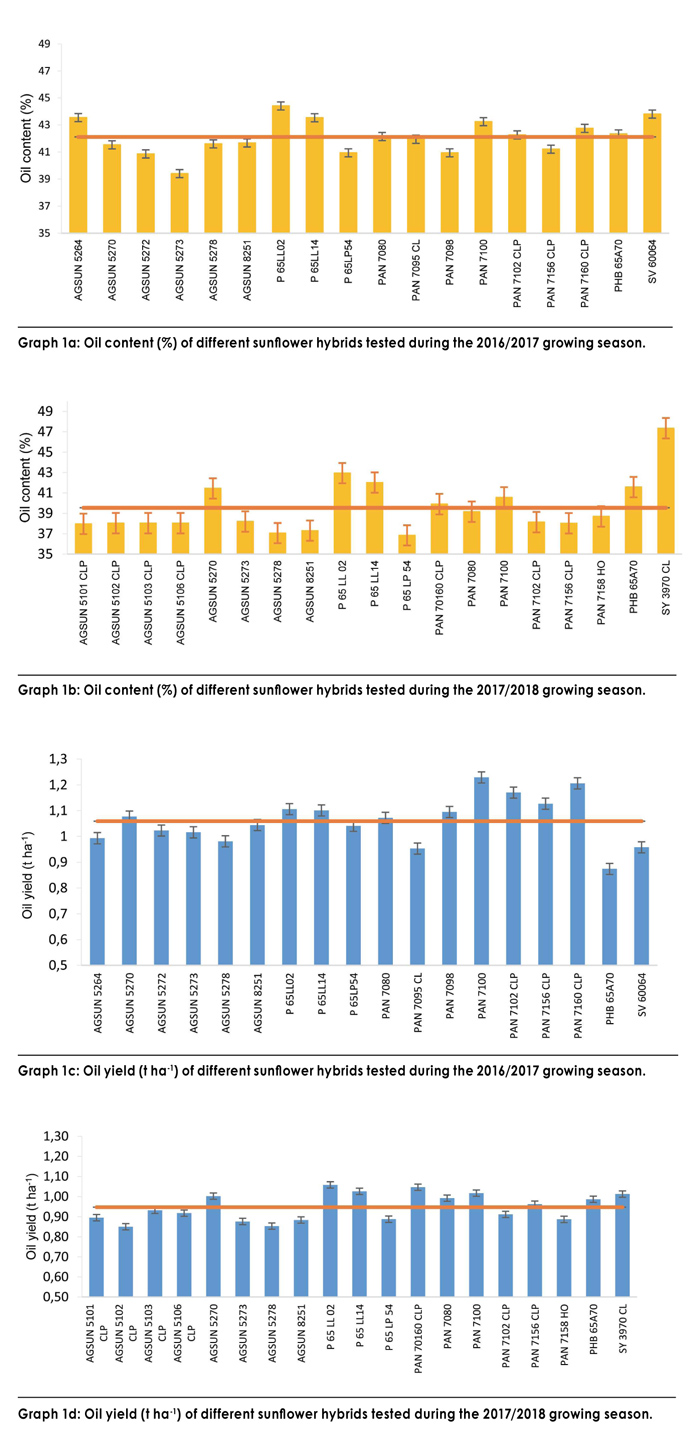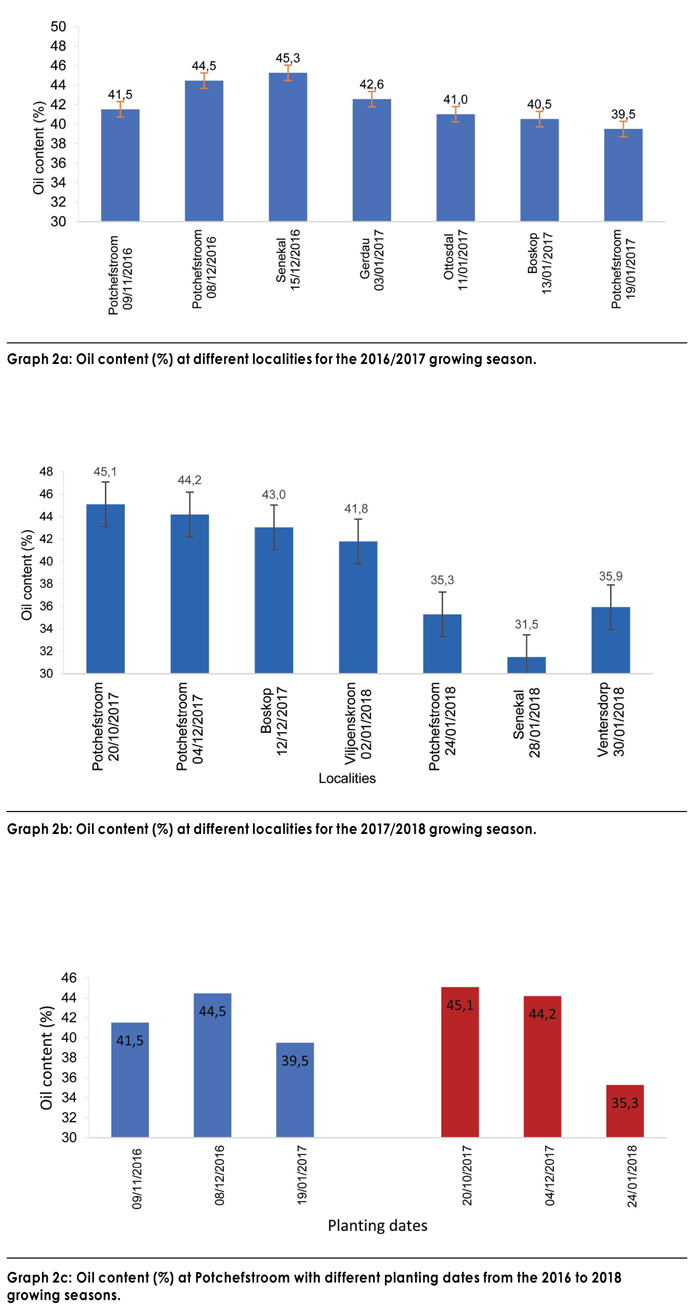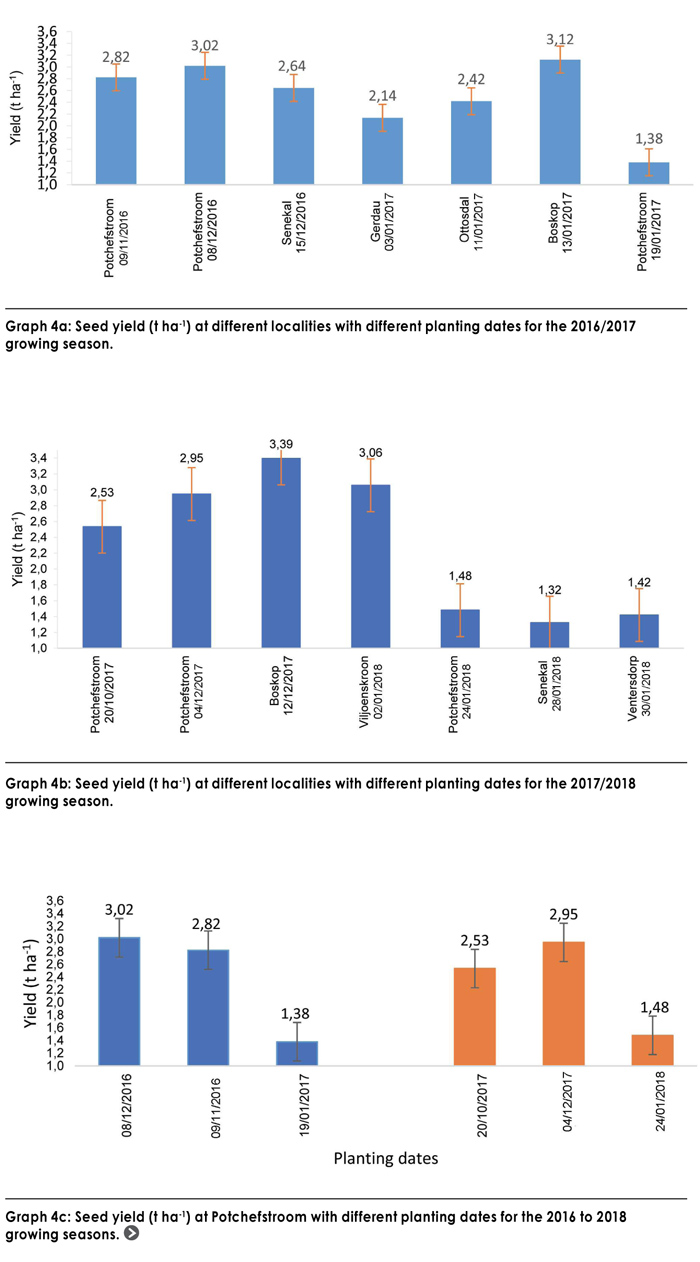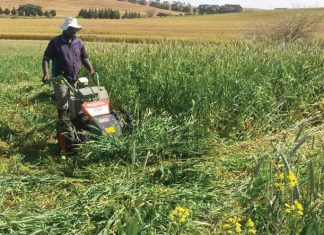
ARC-Grain Crops,
Potchefstroom
Following soybean, peanut and rapeseed, sunflower oil is the fourth most important vegetable oil in world trade with annual sunflower production of around 18 million tons and a cultivated area of over 47 million ha. As it is relatively drought-tolerant and utilises soil nutrients efficiently due to its well-developed and deeply penetrating root system, sunflower is usually grown in rain-fed systems.
South Africa is the only country in Africa that features within the top 15 global sunflower seed producers, ranked at number twelve and making up a 2% share of global output at 49 million tons. Local sunflower seed production reached 874 595 tons in the 2016/2017 production season.
Worldwide, sunflower is mostly produced for its oil. Oil concentration (usually expressed in percent of seed dry mass) mainly determines the industrial yield of the grains. As a consequence, a 2% price premium is given by buyers in some countries for each percentage point the oil content increases between 40% and 45%. However, a 2% price discount is also taken for each point oil content decreases between 40% and 38% and even a larger penalty as oil percentage decreases further. Both seed yield and oil percentage are accordingly of importance to producers in order to maximise gross income.
Under optimum water and nutrient requirements, temperature and intercepted solar radiation play a key role in determining yield components and grain quality in sunflower. Grain oil concentration is mainly determined by the amount of the photosynthetically active radiation intercepted per plant during the grain-filling period. In order to maximise the use of natural resources, the appropriate planting date is very important. This ensures good seed germination as well as the timely appearance of seedlings and the optimum development of the root system.
 Critical periods for yield and quality components
Critical periods for yield and quality components
The relative effect of environmental factors on a given component such as oil content vary according to the crop growth stages, because oil yield components and grain quality are defined in different phenological stages. Seedling emergence is a sensitive stage during sunflower establishment. Abiotic stresses, such as high soil temperatures (above 40°C), can cause delayed emergence, resulting in uneven stand and ultimately poor yields.
A recently conducted South African study indicated that sunflower seedlings exposed to higher than optimal soil temperatures during establishment, experienced impaired seedling development (emergence and root growth). It was also evident that sunflower seedlings can survive and develop at 40°C, but at temperatures higher than this seedling emergence and development will be inhibited.
It has internationally been found that the number of seeds per unit area, which is the main yield component in cereals and oilseed crops, is closely related to the crop growth rate during the critical period for grain set. It was concluded that the critical period for the seed number determination is between 24 and 30 days after anthesis, while grain weight and grain oil concentration are determined during grain filling. It is the only stage during which the determinations of the oil yield components are partially overlapped. Therefore, environmental conditions during this period have a highly significant effect on yield.
In order to investigate the influence of planting date on oil content as well as oil and seed yield of sunflower, fourteen field trials from the sunflower national cultivar evaluation trials were evaluated. It was done at different localities with different planting dates in the North West and the Free State from the 2016 to 2018 growing seasons. A randomised complete block design with three replicates were implemented for each site. Grain yield was recorded for each trial individually and seed samples were sent to the Southern African Grain Laboratory (SAGL) for oil content analyses.
Outcome
Oil concentration and oil yield
Obtaining higher oil concentration varieties appeared to be an alternative track for enhancing sunflower production and could become a plus value for South African producers. Although sunflower oil concentration was reported to be a conservative genetic component, some studies highlighted differential responses of sunflower genotypes in different cropping conditions. Greater variability of oil concentration was either linked to management and environmental conditions or to genotypic and environment interactions.
The moisture free oil concentrations from the 14 field trials during the 2016 to 2018 growing seasons, as analysed by SAGL NPC, are shown in Graphs 1a and 1b.
In the 2016/2017 growing season, the moisture free oil content for cultivars at the seven localities planted during this season varied from 39,4% to 44,4% with an overall mean of 42,1%. The highest oil concentration among cultivars and calculated across localities, was P 65 LL02 at 44,4% followed by SV 60064 at 43,8%. During the 2017/2018 growing season, the moisture free oil content for cultivars at the various localities varied from 36,84 to 47,34% with an overall mean of 39,54%. The highest oil concentration among cultivars and calculated across localities, was SY 3970 CL at 47,34% followed by P 65 LL 02 at 42,94% (Graphs 1a and 1b).
Oil yield per unit area is the product of grain yield and seed oil content (ton ha-1) and was calculated by multiplying oil percentage with seed yield. The oil yield for cultivars at the seven localities during 2016/2017 varied from 0,87 t/ha to 1,23 t/ha with an overall mean of 1,06 t/ha. During the 2017/2018 growing season the oil content varied from 0,85 t/ha to 1,06 t/ha with an overall mean of 0,95 t/ha. PAN 7100 and P 65 LL02 (both conventional sunflower hybrids) produced the highest oil yield for 2016/2017 and 2017/2018 respectively (Graphs 1c and 1d).
 Different planting dates may cause flowering and seed development to occur during periods of widely variable temperatures, radiation, day length and water availability. These variable factors can lead to modification in oil content of the seeds. Graphs 2a and 2b show the effects of localities and planting dates on the oil content (%) during 2016/2017 and 2017/2018. Senekal (planting date 15 December 2016) and Potchefstroom (planting date 8 December 2016) obtained the highest oil content of 45,3% and 44,5% respectively. During the 2017/2018 growing season Potchefstroom (planting date 20 October 2017) had the highest oil content of 45,1%, followed by Potchefstroom (planting date 4 December 2017) with 44,2%. Average oil content was 42,11% and 39,54% during the 2016/2017 and 2017/2018 growing seasons respectively and confirms that oil content is highly affected by genotypes and environment.
Different planting dates may cause flowering and seed development to occur during periods of widely variable temperatures, radiation, day length and water availability. These variable factors can lead to modification in oil content of the seeds. Graphs 2a and 2b show the effects of localities and planting dates on the oil content (%) during 2016/2017 and 2017/2018. Senekal (planting date 15 December 2016) and Potchefstroom (planting date 8 December 2016) obtained the highest oil content of 45,3% and 44,5% respectively. During the 2017/2018 growing season Potchefstroom (planting date 20 October 2017) had the highest oil content of 45,1%, followed by Potchefstroom (planting date 4 December 2017) with 44,2%. Average oil content was 42,11% and 39,54% during the 2016/2017 and 2017/2018 growing seasons respectively and confirms that oil content is highly affected by genotypes and environment.
A comparison of the effects of different planting dates on oil content at the Potchefstroom research farm is presented in Graph 2c. The results indicated that late planting reduced the oil content of sunflower in both growing seasons. Late planting (last week of January) reduced the oil content by 5% and 10% during the 2016/2017 and 2017/2018 growing seasons respectively.
 Oil yield per unit area is the ultimate target in growing high-oil sunflower genotypes. Components of oil yield (number of plants per unit area, grain number, weight per grain and grain oil concentration) and quality (fatty acid composition) are genetically determined, but they can be affected to a different extent by environmental factors that could highly vary during the crop cycle. Oil yield (t/ha) was affected by delaying in planting dates for both seasons. In the 2016/2017 growing season, the highest oil yield was achieved at Potchefstroom, planted in the first week of December, whereas the lowest oil yield (more than half oil yield reduction) was at Potchefstroom with a planting date of 19 January (Graph 3a). In the 2017/2018 growing season, the highest oil yield was recorded at Boskop, planted in the second week of December and the lowest oil yield was recorded in Senekal, planted in the last week of January (Graph 3b). Comparing the oil yield at one locality (Potchefstroom) with different planting dates (Graph 3c), the late planting date (end of January) resulted in a 62% reduction in oil yield during both growing seasons.
Oil yield per unit area is the ultimate target in growing high-oil sunflower genotypes. Components of oil yield (number of plants per unit area, grain number, weight per grain and grain oil concentration) and quality (fatty acid composition) are genetically determined, but they can be affected to a different extent by environmental factors that could highly vary during the crop cycle. Oil yield (t/ha) was affected by delaying in planting dates for both seasons. In the 2016/2017 growing season, the highest oil yield was achieved at Potchefstroom, planted in the first week of December, whereas the lowest oil yield (more than half oil yield reduction) was at Potchefstroom with a planting date of 19 January (Graph 3a). In the 2017/2018 growing season, the highest oil yield was recorded at Boskop, planted in the second week of December and the lowest oil yield was recorded in Senekal, planted in the last week of January (Graph 3b). Comparing the oil yield at one locality (Potchefstroom) with different planting dates (Graph 3c), the late planting date (end of January) resulted in a 62% reduction in oil yield during both growing seasons.
 Seed yield
Seed yield
In the 2016/2017 growing season, the average seed yield of 18 sunflower hybrids at seven localities was 2,50 t/ha. The highest locality mean yield (3,12 t/ha) was recorded at Boskop, planted on 13 January 2017 and the lowest of 1,38 t/ha at Potchefstroom, planted on 19 January 2017 (Graph 4a). The average seed yield of 19 sunflower hybrids at seven localities during 2017/2018 was 2,31 t/ha. The highest locality mean yield of 3,39 t/ha was recorded at Boskop, planted on 12 December 2017 and the lowest of 1,32 t/ha at Senekal, planted on 28 January 2018. Similar to oil yield, late planting (last week of January) during the 2017/2018 growing season produced lower yields than the optimum planting date at all localities (Graph 4b). Significant differences in seed yield were noticed among the tested sunflower hybrids over both seasons. Comparing of yield results at Potchefstroom over two growing seasons and different planting dates, showed that the highest yields were achieved with planting in the first week of December and the lowest yields with planting in the last week of January (Graph 4c). Yield reduction was approximately 50% between the optimum and late planting date over both growing seasons.


Conclusion
This study demonstrated that environmental and agricultural factors such as location, planting date and hybrid may significantly modify oil content and oil yield of sunflower grown in the North West and the Free State. This suggests that these could be used as management tools to improve sunflower seed yield and increased oil content. Significant differences were observed among the sunflower hybrids regarding oil content, oil yield and seed yield. Late planting reduced the seed and oil yield by almost 50 % and oil content reduced significantly compared to the optimum planting date.

















